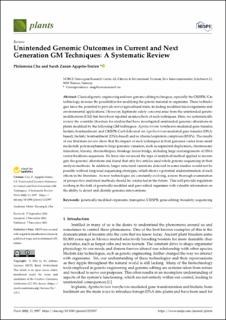| dc.description.abstract | Classical genetic engineering and new genome editing techniques, especially the CRISPR/Cas technology, increase the possibilities for modifying the genetic material in organisms. These technologies have the potential to provide novel agricultural traits, including modified microorganisms and environmental applications. However, legitimate safety concerns arise from the unintended genetic modifications (GM) that have been reported as side-effects of such techniques. Here, we systematically review the scientific literature for studies that have investigated unintended genomic alterations in plants modified by the following GM techniques: Agrobacterium tumefaciens-mediated gene transfer, biolistic bombardment, and CRISPR-Cas9 delivered via Agrobacterium-mediated gene transfer (DNA-based), biolistic bombardment (DNA-based) and as ribonucleoprotein complexes (RNPs). The results of our literature review show that the impact of such techniques in host genomes varies from small nucleotide polymorphisms to large genomic variation, such as segmental duplication, chromosome truncation, trisomy, chromothripsis, breakage fusion bridge, including large rearrangements of DNA vector-backbone sequences. We have also reviewed the type of analytical method applied to investigate the genomic alterations and found that only five articles used whole genome sequencing in their analysis methods. In addition, larger structural variations detected in some studies would not be possible without long-read sequencing strategies, which shows a potential underestimation of such effects in the literature. As new technologies are constantly evolving, a more thorough examination of prospective analytical methods should be conducted in the future. This will provide regulators working in the field of genetically modified and gene-edited organisms with valuable information on the ability to detect and identify genomic interventions. | en_US |

